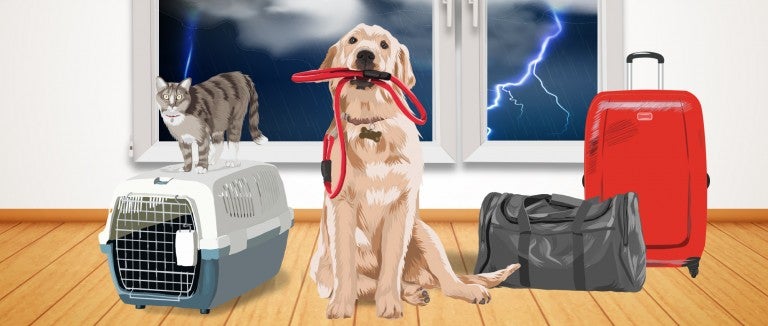Plan for your pets
Make sure that cats and dogs are microchipped and wearing collars with up-to-date identification tags, including your cell phone number. You'll increase your chances of being reunited with pets who get lost by having them microchipped; make sure the microchip registration is in your name. But remember: The average person who finds your pet won't be able to scan for a chip, but they will probably be able to read a basic tag!
Find a trusted neighbor, friend or family member and give them a key. Make sure this backup caretaker is comfortable and familiar with your pets (and vice versa). Make sure your backup caretaker knows your pets’ feeding and medication schedule, location and habits. If you use a pet-sitting service, find out in advance if they’ll be able to help in case of an emergency, such as an unexpected hospital visit or a snowstorm that leaves you stranded.
Make sure all your pets are current on their vaccines and have copies of those records handy. Some of the shelters, rescues, hotels, clinics and boarding kennels that might temporarily house pets during disasters will require vaccination records.
Contact hotels and motels outside your immediate area to find out if they accept pets. Ask about any restrictions on number, size and species. Inquire if a "no pet" policy would be waived in an emergency. Keep a list of animal-friendly places handy and call ahead for a reservation as soon as you think you might have to leave your home. The longer you wait, the less likely there will be vacancies at nearby locations.
Make a list of boarding facilities and veterinary offices that might be able to shelter animals during disasters and emergencies (and make sure to include their 24-hour telephone numbers).
Evacuate early. Don’t wait for a mandatory evacuation order. Evacuating before conditions become severe will keep everyone safer and make the process less stressful. If you need assistance evacuating your residence/shelter, please contact your local Emergency Management Agency.
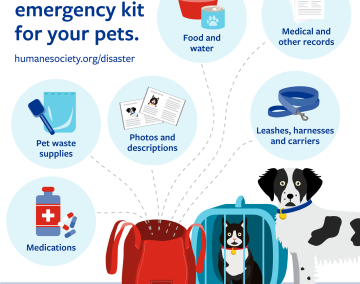
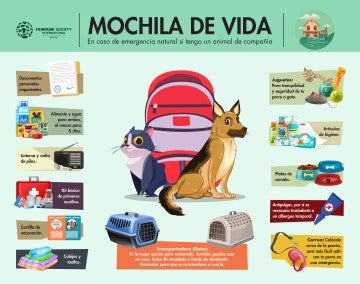
Make a disaster kit for pets
A basic disaster kit for pets should include:
- Food and water for at least five days for each pet, bowls and a manual can opener if you are packing canned pet food. People need at least one gallon of water per person per day. While your pet may not need that much, keep an extra gallon on hand to use if your pet has been exposed to chemicals or flood waters and needs to be rinsed.
- Medications and medical records stored in a waterproof container.
- A pet first aid kit that includes a book on pet first aid, gauze, nonstick tape, pet shampoo, tweezers, antibiotic ointment, styptic powder (for small wounds) and activated charcoal (for poison exposure.) Many pet supply retailers sell pet first aid kits.
- Cat litter box, litter, litter scoop and garbage bags to collect all your pets' waste.
- Sturdy leashes, harnesses and secure carriers to transport pets safely and to ensure that your pets can't escape. Make sure that your cat or dog is wearing a collar and identification that is up to date and visible at all times. Carriers should be large enough to allow your pet to stand comfortably, turn around and lie down. (They may have to stay in it for hours at a time.) If your pet is prone to chewing items, inspect the carrier's inside to ensure that your pet can’t dislodge or ingest items that could cause injury.
- Current photos of you with your pets and descriptions of your pets to help others identify them in case you and your pets become separated—and to prove that they are yours once you're reunited.
- Written information about your pets' feeding schedules, medical conditions and behavior issues along with the name and number of your veterinarian in case you have to board your pets or place them in foster care.
- A favorite toy for comfort and a familiar blanket for warmth, particularly for smaller pets.
If you evacuate, take your pet
If it isn't safe for you, it isn't safe for your pets. You have no way of knowing how long you'll be kept out of the area, and you may not be able—or allowed—to go back for your pets. Pets left behind in a disaster can easily be injured, lost or killed. Remember to make plans for ALL your pets. During disasters, disaster plans for feral or outdoor cats, horses and animals on farms can be lifesavers.
If you’re forced to leave your home because you’ve lost electricity, take your pets with you to a pet-friendly hotel while following public health guidance, or check to see if your local emergency management office has opened pet-friendly cooling or warming centers in the area. If it’s summer, even just an hour or two in the sweltering heat can be dangerous. If it's winter, don't be fooled by your pets' fur coats; it isn't safe to leave them in an unheated house.
Pledge to be a responsible pet owner who will take all your pets with you in an emergency and plan ahead by preparing a disaster kit.
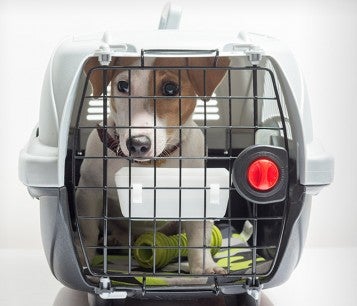
If you stay home, do it safely
If your family and pets must wait out a storm or other disaster at home, identify a safe area of your home where you can all stay together. Put your emergency supplies in that room in advance, including your pet's crate and supplies. Have any medications and a supply of pet food and water inside watertight containers, along with your other emergency supplies. If there is an open fireplace, vent, pet door or similar opening in the house, close it off with plastic sheeting and strong tape.
Close off or eliminate unsafe nooks and crannies where frightened cats may try to hide.
Move dangerous items such as tools or toxic products that have been stored in the area.
Bring your pets indoors as soon as local authorities say trouble is on the way. Keep dogs on leashes and cats in carriers, and make sure they are wearing identification.
Follow local news outlets online or listen to the radio periodically, and don't come out until you know it's safe. You can follow active storms at the National Hurricane Center.
Pets and wildfires
Wildfires have become more intense and destructive in recent years, due to changes in rain and snow patterns, drought-like conditions and land management issues. While wildfires often occur naturally, the area of the western United States affected by them in the past few decades has roughly doubled—leaving many people and animals coping with the disastrous outcomes.
Monitor local air quality regularly throughout the day and adjust your activities according to the recommendations of experts, including wearing a protective mask when appropriate. To help your pets, you must first take care of yourself.
Stay current on wildfire status and evacuation alerts and be ready to move quickly. Be proactive and do not wait longer than necessary; fires can travel much faster than you might expect.
Do not let indoor/outdoor pets roam freely. Their health will be compromised by smoke exposure, they may hide or flee in fear, and you may not be able to locate them quickly in the event of evacuation. Once these pets are confined, make sure all windows, building doors and pet doors are secured.
Keep companion animals indoors with the windows shut. Use air conditioners on recirculate and/or indoor air filter units. Check and clean all HVAC and other filters regularly.
Avoid exercising your pets outdoors. Allow them outside only while leashed and supervised, and only for short periods to relieve themselves.
Take extra care to shield pet birds from smoke exposure and poor air quality. They are particularly sensitive to smoke and the particulates in the air caused by burning materials
Monitor your pets carefully. Wildfire smoke has a greater effect on older and ill animals, particularly those with heart and lung problems. If your pet exhibits signs such as frequent coughing, retching, open-mouthed breathing or gasping, asthma-like symptoms such as wheezing, profuse nasal discharge, swelling or irritation of eyes, unusual weakness, fainting or disinterest in eating or drinking, do not wait for these symptoms to pass or resolve on their own. Promptly contact a veterinary clinic, or if it’s outside normal business hours, call your local 24-hour emergency clinic for advice.
We never know where disasters will strike or when animals may be in need of urgent rescue, but we know we must be ready. Your support makes this lifesaving work possible.
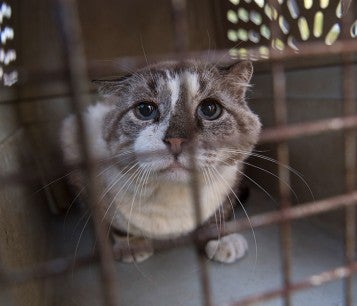
After the emergency
Your home may be a very different place after the emergency is over, and it may be hard for your pets to adjust.
Don't allow your pets to roam loose. Familiar landmarks and smells might be gone, and your pet will probably be disoriented. Pets can easily get lost in such situations. There could also be a lot of debris, such as roofing nails and broken glass, that could cause injuries.
While you assess the damage, keep dogs on leashes and cats in carriers inside the house. If your house is damaged, your pets could escape.
Be patient with your pets after a disaster. Try to get them back into their normal routines as soon as possible. Be ready for behavioral problems caused by the stress of the situation. If these problems persist, or if your pet seems to be having any health problems, talk to your veterinarian.
If your community has been flooded, check your home and yard for wild animals who may have sought refuge there. Wildlife can pose a threat to you and your pet. Check out our tips for humanely evicting wildlife.
If needed, check with your local animal shelter for post-disaster help. Some shelters may be able to provide foster care or shelter for pets in the aftermath of emergency situations. But keep in mind that shelters have limited resources and are likely to be stretched during a local emergency.
Additional resources
- Equine disaster preparedness: Horses require extra consideration in disaster planning
- Livestock disaster preparedness: Be prepared in the event of an emergency
- Community cat disaster preparedness: You can help community (feral and stray) cats before and after a hurricane, earthquake, flood or other disasters
- Wildlife disaster preparedness: You can give wild animals a helping hand during extreme weather
